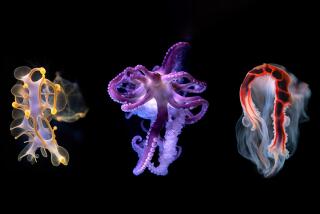Critic’s Choice: Artist Devin Troy Strother’s raucous, rollicking extravaganza in Santa Monica
Devin Troy Strother wowed Los Angeles five year ago with a solo debut that linked pleasure and African American imagery.
That was groundbreaking because of the no-holds-barred nuttiness with which Strother approached fun, and also because pleasure had not played a big part in the discourse that had grown up, since the early 1990s, around art made by African Americans.
In 2012, Strother’s second exhibition showed him to be a formidable storyteller, a master at broaching such loaded subjects as blood, money and sex — or race, class and gender— without getting heavy-handed or glossing over the tough stuff. In 2013, he upped the scale and intensified the impact of his art, making laser-cut silhouettes that amplified the sidesplitting hijinks.
SIGN UP for the free Essential Arts & Culture newsletter >>
All three shows pale in comparison to “They Should’ve Never Given You ... Money,” Strother’s fourth solo show in Los Angeles and his best yet. (The title includes a variation on the N-word.) At Richard Heller Gallery, the 29-year-old artist cranks up the volume, filling two rooms with enough art for six or seven exhibitions.
To an oeuvre that includes paintings, sculptures and collages, Strother adds custom-made carpeting, custom wallpaper, neon signs and three new bodies of work. All commingle in a raucous celebration of color, shape and texture. The double-barreled extravaganza is a throbbing, rollicking party that, like all great art, you have to experience for yourself. It’s also the rare exhibition that makes you want to come back with your friends, just to share the fun.
Half of the walls in the first room have been painted Pepto Bismol pink. The others have been covered with holographic wallpaper. When light hits its silver surface, rainbows appear, their synthetic tints more saturated — and trippy — than the real thing.
On the pink walls, Strother has hung two rows of mixed-media paintings: big ones at eye level and small ones overhead. The 10 little ones feature homemade paper dolls riding gigantic bananas through pink skies filled with marshmallow clouds.
The large ones include so many of these figures that they form abstract patterns. You can pick out individual figures, but most get lost in the crowd as they become part of something that’s bigger than any of us.
The way people stand out from the crowd and disappear into it is Strother’s great subject. That dynamic takes place throughout the exhibition. Boundaries shift. Assumptions crumble. Expectations get derailed. Identities mix.
On the silver walls hang collaged paintings that Strother has squeezed into mass-produced frames. Thick wet brushstrokes get squished against the glass, making for messy reliefs whose uncomfortable beauty embraces accidents.
Another kind of mashing takes place in the second gallery. Strother’s wildly patterned wallpaper and carpeting provide a lively backdrop for his totemic sculptures and smiley-face paintings. The hallucinatory installation calls to mind an impossible constellation of artists. Works by Constantin Brancusi, Victor Vasarely, Yayoi Kusama, Gilbert & George, Andy Warhol, Bruce Nauman, Kara Walker, Michael Reafsnyder and Trenton Doyle Hancock pop into consciousness. More important, they play well with one another.
Getting people going is Strother’s goal. He does so vigorously and generously, with a kind of hospitality that seems to be getting squeezed out by social media. As an antidote, Strother sets the stage, sets the table and stocks the bar so that the fun that follows might engulf us all, its freewheeling pleasures bigger and better than anyone imagined.
Richard Heller Gallery, Bergamot Station, 2525 Michigan Ave., Santa Monica, (310) 453-9191, through Dec. 19. Closed Sundays and Mondays. www.richardhellergallery.com
ALSO:
LACMA’s ‘Rain Room,’ technology’s hot-ticket riff on Mother Nature
Tomory Dodge puts freedom back into the picture at Acme
A foray into clay with stunning results: Richard Hawkins’ ‘New Work’
More to Read
The biggest entertainment stories
Get our big stories about Hollywood, film, television, music, arts, culture and more right in your inbox as soon as they publish.
You may occasionally receive promotional content from the Los Angeles Times.










